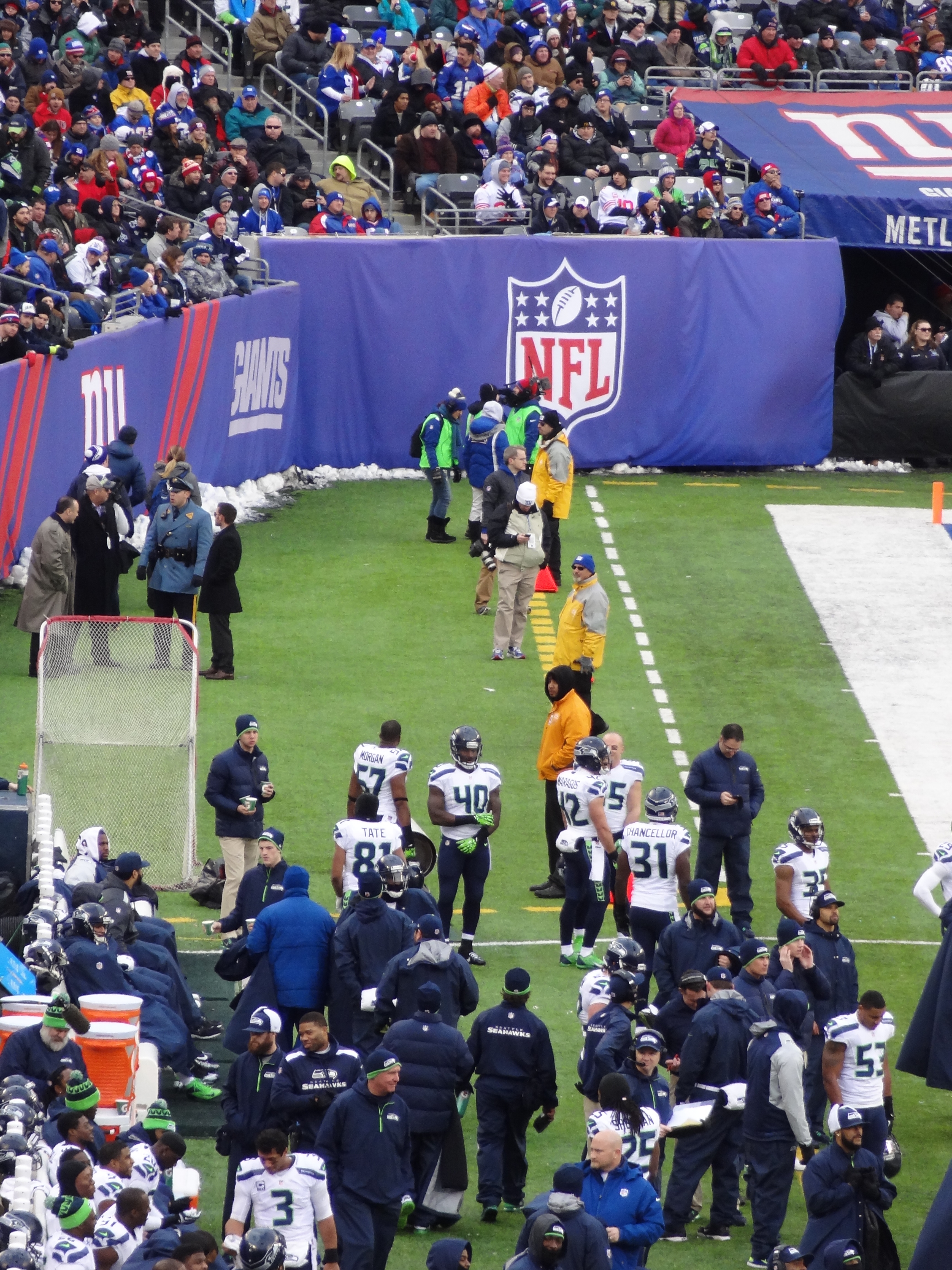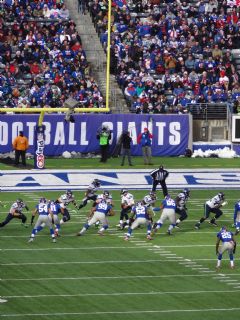With the Seahawks playing the Giants at the weekend, Gerry (pictured below in the midst of game mayhem, in characteristic pose...different sport, same Blackberry addiction!) & I decided it was the perfect opportunity for a catch up over lunch, which proved to be a perfect respite from the rather polar conditions that swept through New York on Saturday. It was great to hear where Gerry's work is leading him now & also to get the news on how his family are settling back into life in Vancouver.
After lunch I was also able to spend some time with Sam (Ramsden), the Performance Director at the Seahawks & someone who I had really enjoyed meeting at their facility last October.
Sam is an innovator & a guy with an open mind, so you can imagine the discussions we have had over the last few months have been really interesting. I am delighted to see how much change Sam has been able to instigate over the course of this past season & it's promising to hear how supportive the head coach has been throughout. The game is changing & they are helping change it.

The match-up on Sunday, was therefore a difficult one for me...good friends & time spent in both camps, gives a dilemma of who to support! As a result, I considered myself a neutral, albeit a very interested one.
Unfortunately, the problems that have been hounding the G Men this season were all too apparent whilst, by comparison, the Seahawks looked every bit the worthy Superbowl contenders that the media here are suggesting. The game played out in a rather one-sided manner & the final whistle concluded a long afternoon that all Giants fans will be happy to consign to the dark annals of history.
I certainly hope that the Seahawks, for all the good work that Sam & his team, including Gerry, are doing, end up back at the MetLife Stadium in February to contest the Superbowl game. It will certainly be an appropriate reflection on the changes being implemented.
Whilst back in Princeton, I received a rather interesting email from a good friend of mine, who is several months post, what he terms, a "Sportsman's hernia" repair. Unfortunately, the operation doesn't appear to have been a resounding success, with the pain, swelling & giving way returning after several weeks. After a repeat consultation & a rather confusing diagnosis of an adductor tear despite no history of trauma, the individual concerned is at a bit of a loss.
The timing of the email coincided with my review of the British Hernia Society's consensus paper on the topic that was published by the BJSM recently.
The paper itself was a useful concept, bringing to the fore the issue with terminology that has long been a problem in this area, as technically speaking, no true hernia exists. It also brought to focus the importance of a solid assessment to provide an accurate differential diagnosis. My concern with many athletes referred with this diagnosis, a thorough examination actually indicates an issue that replicates just one or two of the potential symptoms associated with what is often called a "Sportsmans' groin".
The consensus decided that the term "inguinal disruption" was better suited to describe the condition, which often presents with an increase in tension through the area during forceful twists, turns, sprints & kicks. I personally prefer this label & it is much less leading in its inference.
The consensus went on to provide a suggested definition of an "inguinal disruption" as:
"...pain, either of an insidious or acute onset, which occurs predominantly in the groin area near the pubic tubercle where no obvious other pathology, such as a hernia, exists to explain the symptoms.
The diagnosis of ID can be made if at least three out of the five clinical signs below are detectable
1. Pinpoint tenderness over the pubic tubercle at the point of insertion of the conjoint tendon;
2. Palpable tenderness over the deep inguinal ring;
3. Pain &/or dilation of the external ring with no obvious hernia evident;
4. Pain at the origin of the adductor longs tendon; &
5. Dull, diffused pain in the groin, often radiating to the perineum & inner thigh or across the midline"Unfortunately, I feel that the consensus paper was weak in regards to the research presented in relation to physiotherapeutic & rehabilitative intervention. Whilst several surgeons contributed to the article, only one physiotherapist's opinions were offered & the references cited did not consider functional assessment, components of treatment adjuncts or evidence to support the interventions stipulated.
There were no randomised controlled studies discussed in relation to exercise based rehabilitation, where at the very least a brief introduction to Per Hölmich's work would have been appropriate, given the relevance to football (this was the example of a rehabilitation approach used).
Whilst the physiotherapist involved is very experienced & well respected in football, the section can hardly be considered a "consensus" without wider contribution.
I was further disappointed that the section on screening did not look at the validity or reliability of the various tests suggested & in actual fact was more concerned with components of an assessment as opposed to functional screening. Meanwhile, the topic of injury prevention was not addressed, which given the literature in print that discusses specific strengthening programmes & integration of exercises into warm-up routines, seemed somewhat of an oversight.
Post-operatively, no mention of the manual therapy required to address fascial issues, including scar tissue management, is made. This is an area that I believe is too often overlooked after most surgeries but is critical in relation to inguinal operations.
Speaking from experience, contributing to consensus papers is a time consuming exercise. Drafts, redrafts, revisions, final submissions, submission reviews etc etc, are all demanding of time & attention, which is something that sports physiotherapists seldom have. Surely, other physiotherapists attended the meeting, so I have to wonder why it was deemed appropriate for the burden to rest on one (busy) pair of shoulders? After all, the aim of a consensus paper is to guide best practice, not disseminate the thoughts & works of one practitioner.
Another observation regarding the content of the paper reflects an oft voiced concern regarding the competitive nature of the surgical environment in this field. I've heard it said on many an occasion that "surgeon X has a success rate in excess of 90%", yet am aware of several unsatisfactory outcomes that were reviewed elsewhere. It's a frequently allured to joke that several groin/hernia surgeons are very dismissive of their counterparts' statistics, imaginative when describing their own & the majority of those I have met have made some disparaging remark or other to that effect.
Those of us in the middle, referring to several consultants, have often commented that it would be far more useful if the surgeons weren't so protective of their methods. What happens in practice is that on initial assessment, we have to evaluate the nature of the condition, before then deciding who the best surgeon for the job is. This depends on the progression of the presentation, our knowledge of the various methods that each surgeon adopts & the compatibility of the two. It would be much easier if the various methods were performed by several surgeons depending on the quality of the tissue found under examination.
Reading between the lines of this paper, it appears (as you might expect) that the surgeons not present at the meeting didn't get fair representation of their methods. Understandable but does this, therefore, compromise the validity of a paper promoted as a "consensus paper"?
Please get in touch with your opinions of the paper by submitting a post below...

